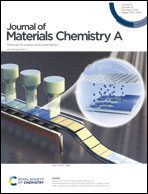Toward all aerosol printing of high-efficiency organic solar cells using environmentally friendly solvents in ambient air†
Abstract
With the surge of the power conversion efficiencies (PCEs) of organic solar cells (OSCs) in recent years, the commercialization of OSCs calls for scalable and environmentally friendly manufacturing techniques. Aerosol printing is a non-contact material deposition method that is compatible with flexible or curved substrates for scaled-up OSC fabrication. Here, by introducing vibrating mesh atomization (VMA) with specific engineering, we demonstrate the first attempt of fabricating OSCs by aerosol printing with the state-of-the-art OSC material of PTQ10:Y6-BO with an environmentally friendly solvent of o-xylene in ambient air. The inks of functional organic materials are converted by VMA into tiny aerosol droplets of ∼5 micrometers, which are passed through a slit printing nozzle to increase the droplet mass flux and suppress the coffee-ring effect. In doing so, favorable arrangement/crystallization of the organic molecules in photoactive layer are realized, leading to OSC devices with PCE up to 15.65%. The VMA is also suitable for printing the hole transport layer and electron transport layer. The all-aerosol-printed OSC devices achieved a PCE of 14.78%. Notably, VMA requires as little as 100 μL solution to prime the fluid lines, making the transition from laboratory experiments to continuous production more economical and practical. To illustrate this advantage, a mini automated production line was built to demonstrate the completion of five steps (printing of three functional layers, and thermal annealing of the hole transport layer and active layer) on a conveyer belt within 30 minutes, marking a concrete step towards manufacturing of high-performance OSCs.



 Please wait while we load your content...
Please wait while we load your content...